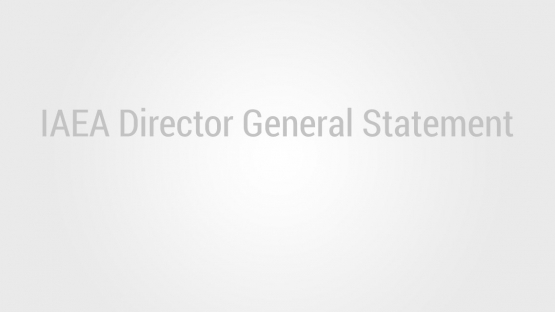Vienna, Austria
Distinguished Congress Participants, Ladies and Gentlemen:
On behalf of the Director General of the International Atomic Energy Agency, and on my own behalf, I wish to extend a warm welcome to all participants of this International Congress of Nutrition of the International Union of Nutritional Sciences.
The IAEA belongs to the United Nations' family and is a specialized organization for the promotion of nuclear technology for peaceful purposes. Many people are surprised to learn that more than two thirds of the Agency's 132 Member States have no nuclear applications in energy, the field most often associated with the Agency. Our main activity to serve these countries, therefore, lies in the promotion of nuclear sciences and applications to meet their basic human needs.
These nuclear applications are in the fields of medicine, agriculture, food production and safety, the environment, in insect pest control, and in the location and improvement of sustainable supplies of drinking water.
We also promote research in these and other areas of the Agency's activities. Many of the nuclear applications, directly or indirectly, impact on the improvement of nutrition in our Member States. I should also mention that the Agency collaborates closely with other UN bodies in the field of nutrition, such as the Food and Agriculture Organization (we run a joint division and laboratories), the World Health Organization, and UNICEF.
As I have said, much of the Agency's work in nuclear applications is relevant to the objectives of this Congress. Most directly related to nutrition are the Agency's activities in research, capacity building and technical co-operation. Research projects have used isotopic techniques as tools for the evaluation of nutritional quality of foods - tools that are uniquely suitable for the assessment of the bio-availability of vitamins and minerals, and thus for determining the success of food supplementation programmes. The Agency's Technical Co-operation programme has been able to apply the results of such research in helping to alleviate nutritional problems in Member States.
Nutrition and health can be regarded as two sides of the same coin. In the field of human health, the nuclear technologies promoted by the Agency use the concepts of prevention, diagnosis, and treatment, and I would like to give some examples of their applications in addressing problems of health throughout the human life cycle.
Those that are based on labeling chemical compounds by isotopes are used in nuclear medicine to diagnose cancer and many other disease, while both stable and radioactive isotopes are efficient means of tracking infections.
The techniques can also be used for measuring the intake of breast milk by a baby, or for the complex monitoring of micronutrient malnutrition (the so called hidden hunger) in vulnerable population segments.
They can be used for the understanding of the origin of obesity in children or predicting the onset of diabetes in adults.
Radiation therapy for treatment of cancer needs no introduction. It may heal, or through palliative radiation, at least reduce the suffering of patients.
Let me now focus on the Agency's role in responding to major nutritional problems:
The IAEA is a partner in addressing nutrition and health problems in more than 50 Member States in close collaboration with local institutions, with other UN organizations and with major donor countries. Large-scale nutrition programmes are expensive to implement and it is thus important to know which food supplements, and which strategies or interventions are most effective. Our strength is in this analytical ground work.
An example of a technique developed through the Agency's programmes is the use of a stable isotope to measure iron bio-availability from foods for the treatment of iron deficiency anaemia. This affects a large fraction of the world's population. The technique is now regarded as the first of its kind for iron studies in humans. Similarly, the measurement of bio-availability of zinc using isotopic means has also become a standard technique.
Another isotopic technique has been brought to bear on the problem protein energy malnutrition in children. Globally, an estimated 200 million children under the age of 5 are moderately to severely underweight. The Agency's efforts in this area of alleviating suffering have included projects in Cameroon and Sri Lanka.
Similarly, Vitamin A deficiency is a major public health problem in several developing countries. The Agency has assisted with the development of isotopic tracer methods for assessing and estimating human vitamin A status in China, Ghana, India, Israel, Peru, the Philippines, South Africa and Thailand.
Another technique assisted through the work of the Agency is the use of dual energy x-ray absorption for the diagnosis and treatment of osteoporosis, a debilitating disorder faced by elderly populations.
I could also mention the use isotopic techniques for the treatment of obesity, which is a risk factor in the development of diabetes. This is a global public health problem and relevant to both developed and developing countries. The technique is aimed at measuring body composition and energy expenditure, and is providing data in Brazil, Chile, China, Cuba, India, Jamaica, Mexico, New Zealand and Nigeria.
I could list many more examples, but let me conclude by saying that isotopic techniques are tools that can help nutritionists to adjust their programmes to become more effective and sustainable. The techniques have been applied in many developing countries and have produced benefits for millions through improved nutrition.
Finally, I would like to record my appreciation to the President of this Congress, Professor Ibrahim Elmadfa, and to Professor Barbara Underwood, President of the Union, for providing the opportunity for the Agency to cooperate in the organization of this important meeting. We look forward to the outcome with great interest.
I wish you a successful congress and a pleasant stay in the city of Vienna.
Thank you.


